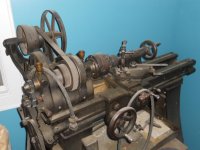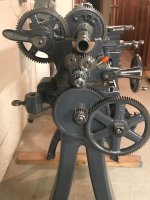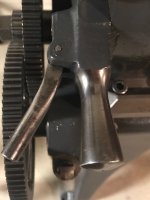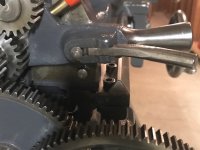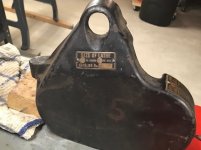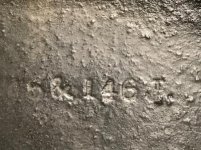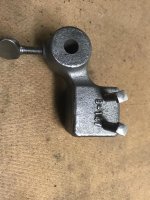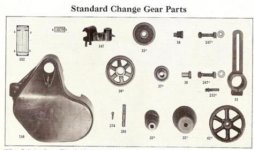Oldmansteve
Plastic
- Joined
- May 12, 2020
Hi all. I wanted to introduce myself, and then ask for some help from those more knowledgable than I. I have been lurking on this site for over a year now, reading everything I could about my old lathe as I try and restore it. I am a not a professional machinist, but more of a machinist wanna-be. I like to work on all things mechanical as a hobby. Over the years I've restored cars, motorcycles, welders, and old machinery. Taught myself how to weld, machine simple things (have a friend with the equipment), fabricate etc. It's sort of decompression for me in what is otherwise a very stressful career at times. I acquired this old lathe (pic below) that had been in storage for a VERY long time. It was grimy, covered in decades of old grease and wood chips/sawdust (they were using it as a wood lathe) but no rust and appeared to be in great mechanical shape. It came with original 3-jaw Chushman chuck, original wrenches, original lantern tool post, original motor, complete bench model countershaft setup, tail chuck, centers, cutting tools etc. but few change gears. I know, I know... few change gears...but for what I wanted it for that was okay. I was determined to restore it as a project and I actually needed a lathe. It sat for over a year because life is busy, but with the coronavirus isolation crisis I suddenly found I had time to work on it. So after a year of research, learning everything I could on these old South Bends, a couple of months ago I finally dug in.
I disassembled the entire lathe, every last nut and bolt and taper pin, bagging and tagging and taking pictures everywhere. Assessing the condition as I proceeded to see if it was going to be worth the effort. I found no chipped or worn gears, the bearings and spindle were pristine, the acme screws had no discernable wear, the half nuts looked like they were never used, and the bed looked great. I was missing a few pieces, notably the gear cover and the carriage chip guard. I degreased, cleaned up, deburred, chased threads etc. everywhere it needed it. I intended to save the old black japaned finish but it literally melted off with the degreaser so had to repaint. In retrospect, I wish I had been more careful and saved the finish because I kind of like my restorations to be just mechanical rejuvenations, and like to keep the vintage patina when I can - I just like the look of honest wear...but I can't undo what's done, so it is what it is. Anyway, after each part was thoroughly inspected and restored, it was masked and painted, then the lathe was lubed, felts replaced etc. and reassembled.
In my process of disassembly I learned how it all worked (which is a great thing - understanding how each part works), and from it's construction and my measurements I was pretty sure what I had. Since the gear cover was missing, I had no brass plate with a model number, but there were clues.
When I obtained it, as you can see in the pic, it had a countershaft that someone had mounted to the legs with a custom fabricated mount (yes, I know the drive pulley is reversed in the pic), someone had also fabricated and attached a chip tray and mounted electrical switches in various places on the legs. These mods were all done long ago. How do I know? Well, because of the wear marks on the mating parts, where grime was and wasn't, the electrical components, vintage switches and wiring etc. The mods were more than 50 years old. (the chip tray that was bolted to it was made from an old tin milk crate that was dated to the 1930's). But once disassembled and cleaned up this is what I found I had:
Casting date 1-8-27, serial #36534 also dates it to 1927.
swing 9”
bed length 3'
6 5/16” between vee ways on the bed
no graduation marks on the tail stock quill
no power feed
eccentric camshaft for back gears
spring loaded lever for reversing gears
bronze spindle bearings without wicks
top oiler
no attachment point on the headstock for a counter shaft adjusting rod (so was a line shaft drive machine and the countershaft was added)
flat belt cone pulley
headstock clamps down to the bed (not bolted)
has factory legs
I looked over many catalogs of the day, read many, many posts, Wells etc., looked at many pics of 1927-28 South Bend 9” lathes, yup, I was certain that I had a 1927 9” Junior. Specifically a South Bend 22-Y. 22 for line shaft 9“ Junior from the catalog, Y for 3' bed and no “B” because mine had factory legs.
So, I went to replace the chip guard on the cross-feed. Found one for a 1927 Junior, bought it, fit perfectly. I also bought a gear cover tagged 22-R which should be the exact same cover that I would need as I have a 22-Y and the only difference is the bed length. Got the cover. Beautiful, original paint and both brass plates and knob, not messed with at all. But it doesn't fit. The distance from the hinge pin to the hole for the spindle is 5 ”. The distance from my bracket's hinge pin hole to the spindle center is 4 1/2”. Okay whats up? I find a pic of another lathe on the forum that is a 1928 9” Junior. Their lathe looks identical to mine, their cover looks identical to mine and their cover bracket looks identical to mine, so why doesn't mine fit? Yet in another pic of a 1928 Junior I see a different bracket. New To Me 1928 South Bend Junior 9" | The Hobby-Machinist So, I figure my bracket must be the wrong bracket after-all and I will have to custom make one or buy a different one. But why would someone buy and change out that bracket to the incorrect one decades ago, when the correct ones were readily available? And that bracket was clearly on my lathe for the better part of 50-100 years. The parts diagrams I have seen show a different bracket than the one I have, but I only have parts diagrams and numbers for the later 9” “workshop” lathe, I can't find any parts listings or diagrams for the 9” Junior model. Curious, I held the cover in place not attaching it to the bracket. Hard to say with certainty (as I am free holding the cover with one hand and manipulating the lever with the other) but it appears the cover won't clear the reversing gears and center on the spindle at the same time - ie doesn't fit my lathe. But I'm not really sure how close to the headstock it is supposed to fit. So I am perplexed. Everything I have read points to a South Bend 9” Junior model 22-Y, yet an unmolested, pristine original 22-R cover doesn't appear to fit, at least not fit the way I see them in pics of other lathes (with the spindle poking through and cover edges tight up against the headstock).
So, questions I have:
1) Do I in fact have a South Bend 9” Junior?
2) If so, isn't this a model 22-Y?
3) If so, why doesn't a model 22-R cover fit?
4) The cone pulley on the headstock looks like (measures) it is for a 1” belt but the 9” Juniors were 1 1/4” (or so I thought) How can that be? I believe the pulley is original but no way to know for certain.
5) For those that haven't noticed already, what is the deal with the reversing lever trigger? The originals I see in pics of 1925's and earlier as well as most 1927's and 1928's were brass, mine is a different shape and is iron but appears original. I did see one (and only one) exactly like mine on a pic of an unrestored 1926 Junior with a serial number only 1500 earlier than mine. Was this a 1 year only part? Photo Index - South Bend Lathe Works - 9" Junior Lathe (Catalog 22-AB) | VintageMachinery.org
6) Another odd thing. No wipers on the carriage. No, they are not just missing, there are no holes drilled there for the screws to hold them. I have read about someone else who had this too, but only that one other example. Every other 1920's 9” Junior had the tapped holes for the carriage wipers. Why is this?
I've done many hours of research and can't figure this lathe out. The only thing I can think of is that South Bend had variations that were not cataloged, but really don't know. Can anyone help? I really want a gear cover and as well as some other accessories, but I need to know exactly what I have. A pic of the lathe when I first obtained it is below. Also attached are pics with restoration underway but headstock not fully assembled as I am awaiting delivery of a needle take up bearing. Pics of the cover and my cover bracket are in the next post.
I hope to contribute as I learn. These are beautifully manufactured machines and using old machinery is a wonderful hobby.
I disassembled the entire lathe, every last nut and bolt and taper pin, bagging and tagging and taking pictures everywhere. Assessing the condition as I proceeded to see if it was going to be worth the effort. I found no chipped or worn gears, the bearings and spindle were pristine, the acme screws had no discernable wear, the half nuts looked like they were never used, and the bed looked great. I was missing a few pieces, notably the gear cover and the carriage chip guard. I degreased, cleaned up, deburred, chased threads etc. everywhere it needed it. I intended to save the old black japaned finish but it literally melted off with the degreaser so had to repaint. In retrospect, I wish I had been more careful and saved the finish because I kind of like my restorations to be just mechanical rejuvenations, and like to keep the vintage patina when I can - I just like the look of honest wear...but I can't undo what's done, so it is what it is. Anyway, after each part was thoroughly inspected and restored, it was masked and painted, then the lathe was lubed, felts replaced etc. and reassembled.
In my process of disassembly I learned how it all worked (which is a great thing - understanding how each part works), and from it's construction and my measurements I was pretty sure what I had. Since the gear cover was missing, I had no brass plate with a model number, but there were clues.
When I obtained it, as you can see in the pic, it had a countershaft that someone had mounted to the legs with a custom fabricated mount (yes, I know the drive pulley is reversed in the pic), someone had also fabricated and attached a chip tray and mounted electrical switches in various places on the legs. These mods were all done long ago. How do I know? Well, because of the wear marks on the mating parts, where grime was and wasn't, the electrical components, vintage switches and wiring etc. The mods were more than 50 years old. (the chip tray that was bolted to it was made from an old tin milk crate that was dated to the 1930's). But once disassembled and cleaned up this is what I found I had:
Casting date 1-8-27, serial #36534 also dates it to 1927.
swing 9”
bed length 3'
6 5/16” between vee ways on the bed
no graduation marks on the tail stock quill
no power feed
eccentric camshaft for back gears
spring loaded lever for reversing gears
bronze spindle bearings without wicks
top oiler
no attachment point on the headstock for a counter shaft adjusting rod (so was a line shaft drive machine and the countershaft was added)
flat belt cone pulley
headstock clamps down to the bed (not bolted)
has factory legs
I looked over many catalogs of the day, read many, many posts, Wells etc., looked at many pics of 1927-28 South Bend 9” lathes, yup, I was certain that I had a 1927 9” Junior. Specifically a South Bend 22-Y. 22 for line shaft 9“ Junior from the catalog, Y for 3' bed and no “B” because mine had factory legs.
So, I went to replace the chip guard on the cross-feed. Found one for a 1927 Junior, bought it, fit perfectly. I also bought a gear cover tagged 22-R which should be the exact same cover that I would need as I have a 22-Y and the only difference is the bed length. Got the cover. Beautiful, original paint and both brass plates and knob, not messed with at all. But it doesn't fit. The distance from the hinge pin to the hole for the spindle is 5 ”. The distance from my bracket's hinge pin hole to the spindle center is 4 1/2”. Okay whats up? I find a pic of another lathe on the forum that is a 1928 9” Junior. Their lathe looks identical to mine, their cover looks identical to mine and their cover bracket looks identical to mine, so why doesn't mine fit? Yet in another pic of a 1928 Junior I see a different bracket. New To Me 1928 South Bend Junior 9" | The Hobby-Machinist So, I figure my bracket must be the wrong bracket after-all and I will have to custom make one or buy a different one. But why would someone buy and change out that bracket to the incorrect one decades ago, when the correct ones were readily available? And that bracket was clearly on my lathe for the better part of 50-100 years. The parts diagrams I have seen show a different bracket than the one I have, but I only have parts diagrams and numbers for the later 9” “workshop” lathe, I can't find any parts listings or diagrams for the 9” Junior model. Curious, I held the cover in place not attaching it to the bracket. Hard to say with certainty (as I am free holding the cover with one hand and manipulating the lever with the other) but it appears the cover won't clear the reversing gears and center on the spindle at the same time - ie doesn't fit my lathe. But I'm not really sure how close to the headstock it is supposed to fit. So I am perplexed. Everything I have read points to a South Bend 9” Junior model 22-Y, yet an unmolested, pristine original 22-R cover doesn't appear to fit, at least not fit the way I see them in pics of other lathes (with the spindle poking through and cover edges tight up against the headstock).
So, questions I have:
1) Do I in fact have a South Bend 9” Junior?
2) If so, isn't this a model 22-Y?
3) If so, why doesn't a model 22-R cover fit?
4) The cone pulley on the headstock looks like (measures) it is for a 1” belt but the 9” Juniors were 1 1/4” (or so I thought) How can that be? I believe the pulley is original but no way to know for certain.
5) For those that haven't noticed already, what is the deal with the reversing lever trigger? The originals I see in pics of 1925's and earlier as well as most 1927's and 1928's were brass, mine is a different shape and is iron but appears original. I did see one (and only one) exactly like mine on a pic of an unrestored 1926 Junior with a serial number only 1500 earlier than mine. Was this a 1 year only part? Photo Index - South Bend Lathe Works - 9" Junior Lathe (Catalog 22-AB) | VintageMachinery.org
6) Another odd thing. No wipers on the carriage. No, they are not just missing, there are no holes drilled there for the screws to hold them. I have read about someone else who had this too, but only that one other example. Every other 1920's 9” Junior had the tapped holes for the carriage wipers. Why is this?
I've done many hours of research and can't figure this lathe out. The only thing I can think of is that South Bend had variations that were not cataloged, but really don't know. Can anyone help? I really want a gear cover and as well as some other accessories, but I need to know exactly what I have. A pic of the lathe when I first obtained it is below. Also attached are pics with restoration underway but headstock not fully assembled as I am awaiting delivery of a needle take up bearing. Pics of the cover and my cover bracket are in the next post.
I hope to contribute as I learn. These are beautifully manufactured machines and using old machinery is a wonderful hobby.


